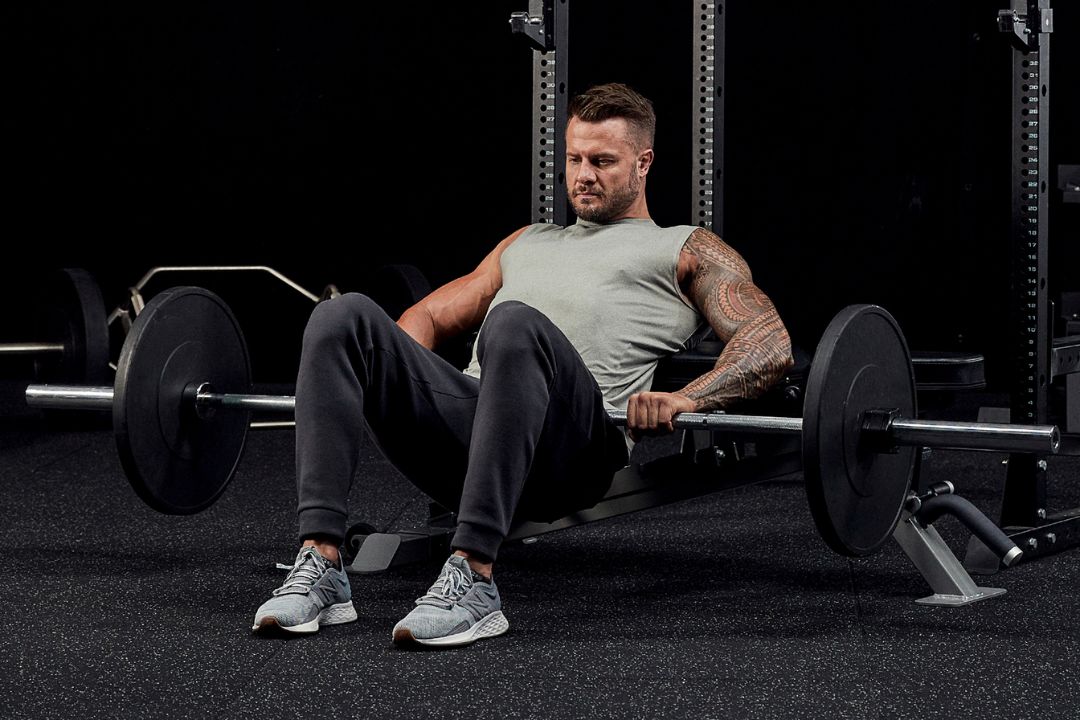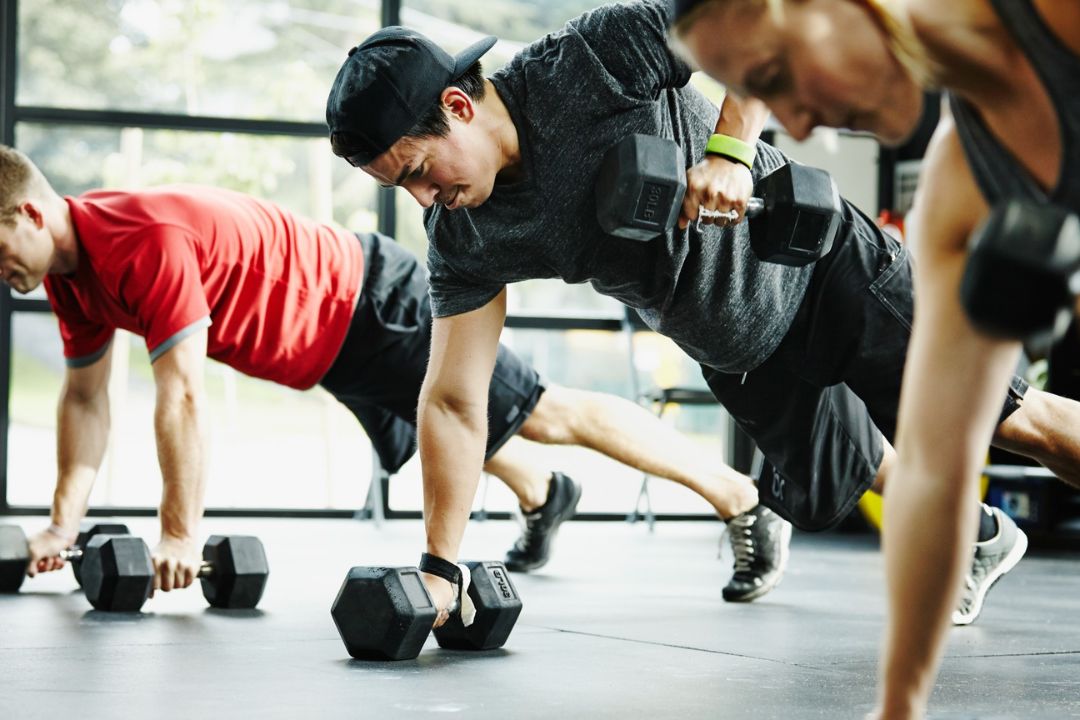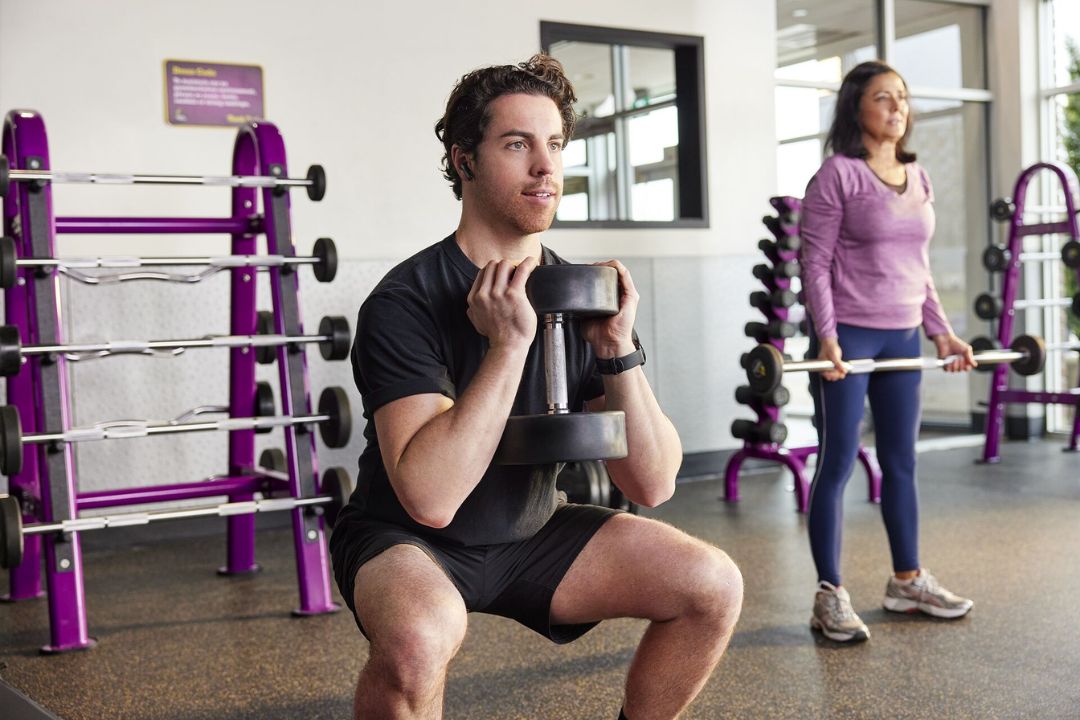
Post by : Zayd Kamal
Strength training has changed a lot over the years. It used to focus mainly on traditional lifting techniques, like heavy weightlifting. These classic methods were great for building muscle mass and strength, but they've evolved into something more versatile and dynamic.
Today, the spotlight is on functional fitness. This new approach isn't just about lifting heavy weights. Instead, it focuses on exercises that mimic real-life movements, helping to improve your overall body strength and coordination.
Functional fitness is special because it blends different types of exercises that work on multiple muscle groups at once. This means it's not just about isolating one muscle group but engaging your whole body. Exercises often include bodyweight movements, resistance bands, and other equipment, making workouts more varied and fun.
Functional fitness has several benefits. It helps you move better in everyday life, whether you're playing sports, carrying groceries, or just getting around. It also enhances your balance and flexibility, which can help prevent injuries and improve your overall health.
Many people find that combining traditional lifting with functional fitness gives them the best of both worlds. While traditional lifting builds muscle and strength, functional fitness helps with everyday movement and overall body function. This mix can lead to a well-rounded and effective fitness routine.
If you're new to functional fitness, you can start by incorporating simple exercises that mimic daily activities. Think of movements like squatting to pick up objects, or lunging to reach for things. As you get more comfortable, you can explore more advanced exercises and equipment.
Functional fitness is worth trying because it makes your workouts more engaging and relevant to your daily life. Plus, it's adaptable for all ages and fitness levels, making it a great choice for everyone from kids to adults.

Traditional strength training typically involves lifting heavy weights. This method is designed to make muscles stronger and bigger over time. By lifting weights like dumbbells and barbells, you engage different muscle groups, making them work harder and grow stronger.
Some of the most well-known exercises in traditional strength training include the bench press, squats, and deadlifts. Each of these exercises targets specific muscles and helps improve overall strength. For example, the bench press works the chest and arms, while squats focus on the legs and glutes.
In traditional lifting, exercises are often aimed at isolating particular muscle groups. This means that each exercise is designed to work one muscle group at a time, helping to build that muscle more effectively. For instance, bicep curls target the biceps, while tricep extensions focus on the triceps.
Traditional strength training usually follows a structured routine. This routine involves specific sets and repetitions of each exercise, which helps track progress and ensure muscles are being worked properly. A typical workout might include several sets of 8-12 repetitions for each exercise.
Traditionally, strength training is done in a gym setting where equipment like free weights and machines are readily available. The gym environment provides access to a wide range of equipment designed for strength training, making it easier to follow a diverse workout routine.
One of the main goals of traditional strength training is to increase muscle mass. By progressively lifting heavier weights, muscles are forced to adapt and grow. This increase in muscle mass contributes to overall strength and endurance.
Beyond muscle growth, traditional strength training also focuses on improving overall strength. By challenging the muscles with heavy weights, you enhance your ability to perform various physical tasks, from lifting heavy objects to participating in sports.

Functional fitness focuses on exercises that mimic everyday activities. Instead of just lifting weights in a gym, you might do moves like squats or lunges that help you carry groceries or climb stairs more easily. This makes exercise more practical and fun for daily life!
Unlike traditional strength training that targets specific muscles, functional fitness engages your entire body. Activities like jumping, balancing, and twisting work multiple muscle groups at once. This approach helps improve your overall strength, balance, and coordination.
One of the best things about functional fitness is that you don’t need fancy equipment. You can use your body weight, resistance bands, or simple items like a chair. This makes it easy to exercise anywhere—at home, in the park, or even at school!
Functional fitness is designed to improve how your body moves and handles stress. By strengthening your core and stabilizing muscles, you can reduce the risk of injuries. It helps your body adapt better to sudden movements or strains.
Functional fitness exercises often involve stretching and moving through different ranges of motion. This helps keep your joints flexible and your muscles limber. Flexibility is key to staying active and preventing stiffness as you grow.
Many functional fitness exercises are dynamic and exciting. You might find yourself doing jumping jacks, burpees, or agility drills. These activities not only improve your fitness but also make working out more enjoyable.
Whether you're running, jumping, or just moving around, functional fitness helps you perform better. It makes daily activities like playing sports, carrying heavy objects, or even sitting at a desk easier and more comfortable.

Functional fitness is all about exercises that mimic everyday activities. Instead of just lifting weights, you’re doing movements like squats and lunges that help you with real-life tasks. This makes functional fitness super useful for improving how you move and feel in your daily life.
Unlike traditional exercises that focus on specific muscle groups, functional fitness engages multiple muscles at once. This means your workout helps with strength, balance, and coordination, giving you a more complete and effective fitness routine.
One of the coolest things about functional fitness is that it can be done anywhere. You don’t need fancy equipment or a gym membership. Whether you’re at home, in a park, or even on vacation, you can do functional exercises with just your body or simple tools like resistance bands.
Functional fitness focuses on improving your body’s overall movement and stability. This helps strengthen your core and stabilizing muscles, which can reduce the risk of injuries. Better balance and stronger muscles mean you’re less likely to get hurt during everyday activities.
Many functional fitness exercises include stretches and movements that boost your flexibility and joint mobility. This is great for keeping your body agile and preventing stiffness, making it easier to move and play.
Functional fitness workouts can be more fun than traditional routines because they often include varied and dynamic exercises. You might use kettlebells, do high-intensity interval training (HIIT), or even play games that get you moving. This variety keeps workouts interesting and enjoyable.
By focusing on functional movements, these workouts help you perform daily tasks better, like carrying groceries, playing sports, or even climbing stairs. It’s all about making everyday activities easier and more comfortable.
Functional fitness isn’t just for adults; it’s great for kids and teens too. Exercises can be adapted for different ages and fitness levels, making it a versatile option for the whole family.

Functional fitness helps you move better in your daily life. Imagine being able to carry groceries, climb stairs, or play sports with ease. By training with exercises that mimic real-life activities, you get stronger and more coordinated for these everyday tasks.
Through various functional exercises, you work on your balance and stability. This means fewer slips and falls, whether you're walking on uneven ground or playing a game. Better balance helps you stay safe and feel confident in all kinds of situations.
A strong core is essential for nearly everything you do. Functional fitness focuses a lot on core exercises that strengthen your stomach, back, and sides. This strong core supports your whole body, improving your posture and reducing back pain.
Functional fitness exercises often include stretches and movements that increase flexibility. This means your muscles and joints become more flexible and move better. Improved flexibility helps you reach, bend, and twist more easily.
By engaging in functional exercises, you help keep your joints healthy. Functional fitness often includes low-impact movements that are gentle on the joints while still building strength. This can help prevent joint problems and keep you feeling good.
One of the best parts of functional fitness is how varied and fun it can be. From jumping rope to using resistance bands, there are many different exercises to try. This variety keeps your workouts interesting and exciting, so you're more likely to stick with them.
Functional fitness can help you recover more quickly from injuries. By strengthening your body and improving your movement patterns, you help your muscles and joints heal faster and get back to your normal activities.
Exercise is known to boost mood and reduce stress. Functional fitness, with its diverse and engaging workouts, can make exercise feel more enjoyable and less like a chore. This can lead to better mental health and a more positive outlook on life.

Combining traditional lifting with functional fitness merges two powerful training methods. Traditional lifting focuses on building muscle and strength with classic exercises like bench presses and squats. Functional fitness, on the other hand, emphasizes movements that improve daily activities and overall body coordination. By blending these approaches, you get the best of both worlds—muscle growth and practical strength.
Traditional lifting targets specific muscle groups, helping to increase power and size. Functional fitness engages multiple muscles simultaneously, improving balance, flexibility, and coordination. This mix ensures a balanced workout routine that enhances not only muscle strength but also overall body performance and agility.
Traditional lifting builds raw strength, which is crucial for many activities. Functional fitness complements this by improving how you use that strength in real life. For example, while lifting weights increases your upper body strength, functional exercises like squats and lunges help you move better and more efficiently in everyday tasks.
Incorporating functional fitness exercises helps strengthen stabilizing muscles and improve joint mobility. This can reduce the risk of injuries that might occur from traditional lifting. Additionally, functional exercises can aid in recovery by enhancing flexibility and promoting better movement patterns.
Combining these two methods keeps workouts exciting and varied. Traditional lifting can become repetitive, but adding functional fitness exercises brings variety and fun to your routine. This variety helps maintain motivation and makes working out more enjoyable.
While traditional lifting builds muscle, functional fitness ensures that you can use that muscle effectively. This combination leads to better overall fitness, helping you perform daily activities with greater ease and efficiency. Whether you're lifting heavy objects or playing sports, a well-rounded fitness routine will support your performance.
You can adjust the balance between traditional lifting and functional fitness based on your goals. If you're looking to increase muscle size, focus more on lifting. If you want to improve overall movement and agility, incorporate more functional exercises. This personalized approach allows you to tailor your fitness routine to your needs and preferences.
Strength training has come a long way from its traditional roots. Initially focused on heavy lifting with classic exercises like bench presses and squats, it has evolved to include functional fitness. This new approach emphasizes exercises that mimic real-life movements, enhancing overall body strength and coordination. By combining traditional lifting with functional fitness, you can achieve both muscle growth and practical strength. This blend offers a balanced workout routine that improves muscle power, flexibility, balance, and overall performance. It also helps with injury prevention and keeps workouts varied and engaging.
Functional fitness exercises, which often use body weight, resistance bands, and simple tools, make workouts accessible and fun. They improve everyday movement, balance, flexibility, and core strength. This combination of traditional lifting and functional fitness provides a comprehensive fitness routine, suitable for all ages and fitness levels. Adjusting the balance between these methods allows for personalized training based on individual goals.
DXB News Network would like to remind readers that while combining traditional lifting with functional fitness offers many benefits, it's essential to consult with a fitness professional or healthcare provider before starting any new workout regimen. Individual results may vary, and it's important to ensure that exercises are performed safely and correctly. Always listen to your body and adapt your fitness routine as needed.
Traditional lifting involves exercises that use heavy weights to build muscle mass and strength. Common exercises include bench presses, squats, and deadlifts. These exercises target specific muscle groups to increase size and power.
Functional fitness focuses on exercises that mimic real-life movements. This approach aims to improve overall body strength, coordination, balance, and flexibility. Functional exercises often involve bodyweight movements, resistance bands, and other equipment.
Combining these methods provides a balanced workout routine. Traditional lifting builds muscle and strength, while functional fitness enhances movement and overall body performance. This blend improves both muscle growth and practical strength, leading to better overall fitness.
Yes, functional fitness can help prevent injuries by strengthening stabilizing muscles and improving joint mobility. These exercises enhance balance and flexibility, reducing the risk of strains and injuries.
Functional fitness exercises include squats, lunges, jumping jacks, and agility drills. These movements mimic everyday activities and engage multiple muscle groups simultaneously, improving overall strength and coordination.

Feeling tired all day? Doctor warns it can be a sign of iron deficiency, suggests ways to boost iron levels
Feeling constantly tired? Low iron may be the cause. Doctor explains signs of deficiency and shares

Ranbir Kapoor’s Fitness Coach Says All Calories Are Not Equal, Explains How Metabolism Shapes Weight Loss
Ranbir Kapoor’s fitness coach explains how calories from sugar and protein affect the body different

Smriti Mandhana to Harleen Deol: The most stylish star cricketers of Indian Women's Cricket Team
From Smriti Mandhana to Harleen Deol, explore the fashion and style choices of India’s women cricket

Dermatologist explains which social media skincare trends actually work
From Vaseline slugging to ice facials, dermatologist Dr Aparajita Lamba reveals which viral skincare

Hormone expert explains how to protect your body as Delhi’s air quality worsens
Delhi’s toxic air is harming lungs, heart and hormones. Expert shares simple ways to strengthen the

The Chair Company Costume Designer Says Show Focuses on Real-Life Clothing, Not Fashion
Costume designer Nicky Smith says clothes in The Chair Company are thrifted and imperfect to show re

Fitness Coach Says Cutting Rice and Roti Won’t Help in Weight Loss, Shares Practical Tips
Fitness coach Jeet Selal explains that avoiding rice and roti is not needed for fat loss. Balanced e

Zohran Mamdani Victory Speech Goes Bollywood with Dhoom Machale
Zohran Mamdani wins NYC mayor race, becoming the city’s first Muslim and South Asian mayor, making h

UAE Life High Stress 3 Simple Ways Expats Can Manage Pressure
Expats in the UAE face daily pressure and burnout Learn 3 simple effective ways to manage stress fin

Smart Meal Prep in Dubai Save Money Stay Healthy
Plan smart eat fresh Discover how meal prepping in Dubai helps you save money eat healthy and enjoy

The Ultimate Guide to Dieting in Dubai Keto vs Vegan vs Mediterranean
Discover Dubai’s top diet trends Keto Vegan and Mediterranean Find which plan fits your lifestyle f

Stay Fit in Dubai 7 Fun Outdoor Workouts Without a Gym
Explore 7 fun ways to stay fit in Dubai from beach runs to desert hikes and skyline yoga No gym nee

Beyond Biryani: Mastering Portion Control in Dubai’s Melting Pot of Cuisines
Discover how to enjoy Dubai’s diverse cuisines wisely Learn simple portion control tips to stay heal

Fabien Marchand — The Infinite Brushstroke of Freedom
French artist Fabien Marchand explores freedom, color, and emotion through his evolving art — bridgi

Dubai’s Healthy Food Revolution 5 Global Wellness Trends Transforming the City
Discover how Dubai is embracing a global wellness wave with plant based diets organic food and smart